Their hands protected by layers of tightly bound tape, the players take turns swatting a small, hard ball at speeds that reach 115 kilometers (71.4 miles) per hour.
They are playing a match of Pelota Vasca, or "Basque Ball," a sport popular to its native Basque region that overlaps northern Spain and southwestern France. The game is similar to squash, but played without a racket and with only three walls.
Click to Gallery
In this Thursday, Feb. 28, 2019 photo, Victor Esteban, 25 years old, a player of Basque Ball, known as "pelotari", prepares and protects his hands ahead of a training session, in Pamplona, northern Spain. With their hands protected by layers of tightly-bound tape, the players take turns swatting a small, hard ball at speeds that reach 115 kilometers (71.4 miles) per hour. (AP PhotoAlvaro Barrientos)
In this Thursday, Feb. 28, 2019 photo, Victor Esteban, 25, a player of Basque Ball, returns the ball on a Labrit court or fronton, in Pamplona, northern Spain. With their hands protected by layers of tightly-bound tape, the players take turns swatting a small, hard ball at speeds that reach 115 kilometers (71.4 miles) per hour. (AP PhotoAlvaro Barrientos)
In this Thursday, Feb. 28, 2019 photo, Victor Esteban, a player of Basque Ball, known as "pelotari", prepares and protects his hands ahead of a training session, in Pamplona, northern Spain. With their hands protected by layers of tightly-bound tape, the players take turns swatting a small, hard ball at speeds that reach 115 kilometers (71.4 miles) per hour. (AP PhotoAlvaro Barrientos)
In this Thursday, Feb. 28, 2019 photo, Victor Esteban, 25, a player of Basque Ball, warms up at Labrit court or fronton, in Pamplona, northern Spain. With their hands protected by layers of tightly-bound tape, the players take turns swatting a small, hard ball at speeds that reach 115 kilometers (71.4 miles) per hour. (AP PhotoAlvaro Barrientos)
Their hands protected by layers of tightly bound tape, the players take turns swatting a small, hard ball at speeds that reach 115 kilometers (71.4 miles) per hour.
Pelota Vasca was traditionally played in the village square facing a church, whose facade offered a perfect wall for players to hit the ball.
Other varieties can be played with a racket or a hoop, but the traditional style is just to whack the ball with the open hand.
More AP sports: https://apnews.com/apf-sports and https://twitter.com/AP_Sports
In this Saturday, March 9, 2019 photo, Basque Ball player or "pelotari" Victor Esteban, returns the ball during a match at Labrit court or fronton, in Pamplona, northern Spain. With their hands protected by layers of tightly-bound tape, the players take turns swatting a small, hard ball at speeds that reach 115 kilometers (71.4 miles) per hour. (AP PhotoAlvaro Barrientos)
In this Saturday, March 9, 2019 photo, basque ball player or "pelotari" Jon Albizu, jumps to return the ball during a match on a Labrit court or fronton, in Pamplona, northern Spain. With their hands protected by layers of tightly-bound tape, the players take turns swatting a small, hard ball at speeds that reach 115 kilometers (71.4 miles) per hour. (AP PhotoAlvaro Barrientos)
In this Thursday, Feb. 28, 2019 photo, Basque Balls items are displayed at a store in Pamplona, northern Spain. With their hands protected by layers of tightly-bound tape, the players take turns swatting a small, hard ball at speeds that reach 115 kilometers (71.4 miles) per hour. (AP PhotoAlvaro Barrientos)
In this Thursday, Feb. 28, 2019 photo, Victor Esteban, 25 years old, a player of Basque Ball, known as "pelotari", prepares and protects his hands ahead of a training session, in Pamplona, northern Spain. With their hands protected by layers of tightly-bound tape, the players take turns swatting a small, hard ball at speeds that reach 115 kilometers (71.4 miles) per hour. (AP PhotoAlvaro Barrientos)
In this Thursday, Feb. 28, 2019 photo, different models of Basque balls are displayed for sale at a store in Pamplona, northern Spain. With their hands protected by layers of tightly-bound tape, the players take turns swatting a small, hard ball at speeds that reach 115 kilometers (71.4 miles) per hour. (AP PhotoAlvaro Barrientos)
In this Thursday, Feb. 28, 2019 photo, Victor Esteban, 25, a player of Basque Ball, returns the ball on a Labrit court or fronton, in Pamplona, northern Spain. With their hands protected by layers of tightly-bound tape, the players take turns swatting a small, hard ball at speeds that reach 115 kilometers (71.4 miles) per hour. (AP PhotoAlvaro Barrientos)
In this Thursday, Feb. 28, 2019 photo, Victor Esteban, a player of Basque Ball, known as "pelotari", prepares and protects his hands ahead of a training session, in Pamplona, northern Spain. With their hands protected by layers of tightly-bound tape, the players take turns swatting a small, hard ball at speeds that reach 115 kilometers (71.4 miles) per hour. (AP PhotoAlvaro Barrientos)
In this Saturday, March 9, 2019 photo, Victor Esteban, center, prepares to hit the ball with his hand during a match at Labrit court or fronton, in Pamplona, northern Spain. With their hands protected by layers of tightly-bound tape, the players take turns swatting a small, hard ball at speeds that reach 115 kilometers (71.4 miles) per hour. (AP PhotoAlvaro Barrientos)
In this Tuesday, March 5, 2019 photo, players of Basque Ball hold balls on their hands protected by layers of tightly-bound tape, in Pamplona, northern Spain. With their hands protected by layers of tightly-bound tape, the players take turns swatting a small, hard ball at speeds that reach 115 kilometers (71.4 miles) per hour. (AP PhotoAlvaro Barrientos)
In this March 1, 2019 photo, players of Basque Ball known as "pelotari", use tape to protect their hands ahead of a match at Labrit court or fronton, in Pamplona, northern Spain. With their hands protected by layers of tightly-bound tape, the players take turns swatting a small, hard ball at speeds that reach 115 kilometers (71.4 miles) per hour. (AP PhotoAlvaro Barrientos)
In this Thursday, Feb. 28, 2019 photo, Victor Esteban, 25, a player of Basque Ball, warms up at Labrit court or fronton, in Pamplona, northern Spain. With their hands protected by layers of tightly-bound tape, the players take turns swatting a small, hard ball at speeds that reach 115 kilometers (71.4 miles) per hour. (AP PhotoAlvaro Barrientos)
The court is called a "Fronton," and players can play the ball off the front, back and the left-side wall. The right wall is missing.
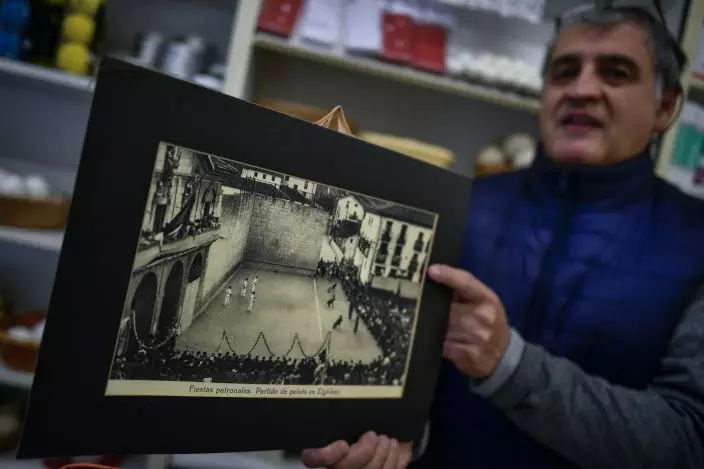
In this Thursday, Feb. 28, 2019 photo, Javier Bariain shows an old photograph of a Basque Ball or "pelota vasca" match, at his store in Pamplona, northern Spain. With their hands protected by layers of tightly-bound tape, the players take turns swatting a small, hard ball at speeds that reach 115 kilometers (71.4 miles) per hour. (AP PhotoAlvaro Barrientos)
Pelota Vasca was traditionally played in the village square facing a church, whose facade offered a perfect wall for players to hit the ball.
Now it is a professional sport played indoors with organized tournaments in northern Spain played by individuals or doubles, where many spectators bet on the winner. As a trophy, the winner of the annual championship is awarded a large green Basque beret, called the "Txapela." The champion is called the "Txapeldun."
The handmade ball was originally made from a small hard plastic core bound with strips of cat intestine and wool thread, with an outer layer made of dried sheep skin. Today the balls go through a more industrial process, with synthetic materials being used.
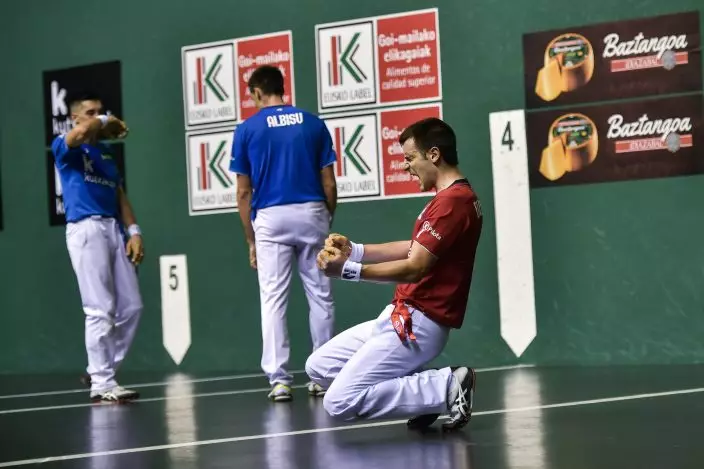
In this Saturday, March 9, 2019 photo, Basque Ball player or "pelotari" Danel Elezkano, right, celebrates winning the match 22-10 at Labrit court or fronton, in Pamplona, northern Spain. With their hands protected by layers of tightly-bound tape, the players take turns swatting a small, hard ball at speeds that reach 115 kilometers (71.4 miles) per hour. (AP PhotoAlvaro Barrientos)
Other varieties can be played with a racket or a hoop, but the traditional style is just to whack the ball with the open hand.
Players, called "pelotari," can spend an hour before a match preparing their hands. They coat their fingers and palms with a wax covering that they first heat up with a flame. Then they wrap each finger in layers of tape and some thin foam padding to reduce the risk of injury.
The players bend backward like tennis players taking a serve to generate power. The impact of the ball is clearly heard in the stands. It can often be painful, making players grimace when they strike the ball incorrectly.

In this Thursday, Feb. 28, 2019 photo, a poster with photographs showing how to protect the hands to practice the Basque Ball or "pelota vasca", at a store in Pamplona, northern Spain. With their hands protected by layers of tightly-bound tape, the players take turns swatting a small, hard ball at speeds that reach 115 kilometers (71.4 miles) per hour. (AP PhotoAlvaro Barrientos)
More AP sports: https://apnews.com/apf-sports and https://twitter.com/AP_Sports
Visit the AP Images blog: http://apimagesblog.com
Visit AP Images online: http://www.apimages.com
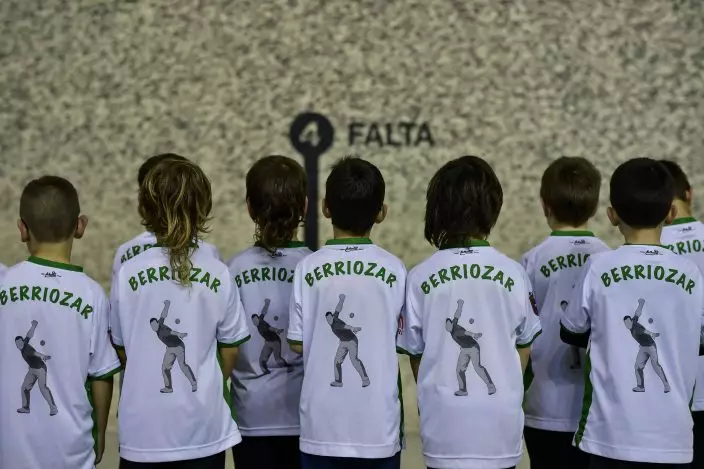
In this Thursday, Feb. 28, 2019 photo, a group of young players of Basque Ball or "pelota vasca" take part in a training session, in Berriozar, near Pamplona, northern Spain. With their hands protected by layers of tightly-bound tape, the players take turns swatting a small, hard ball at speeds that reach 115 kilometers (71.4 miles) per hour. (AP PhotoAlvaro Barrientos)
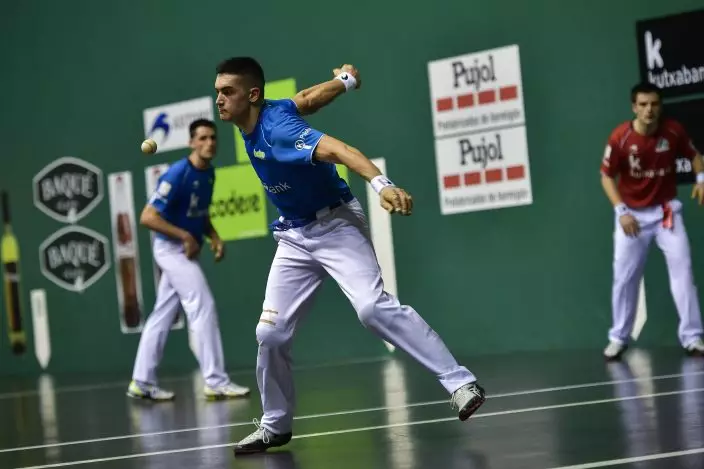
In this Saturday, March 9, 2019 photo, Basque Ball player or "pelotari" Victor Esteban, returns the ball during a match at Labrit court or fronton, in Pamplona, northern Spain. With their hands protected by layers of tightly-bound tape, the players take turns swatting a small, hard ball at speeds that reach 115 kilometers (71.4 miles) per hour. (AP PhotoAlvaro Barrientos)

In this Saturday, March 9, 2019 photo, basque ball player or "pelotari" Jon Albizu, jumps to return the ball during a match on a Labrit court or fronton, in Pamplona, northern Spain. With their hands protected by layers of tightly-bound tape, the players take turns swatting a small, hard ball at speeds that reach 115 kilometers (71.4 miles) per hour. (AP PhotoAlvaro Barrientos)
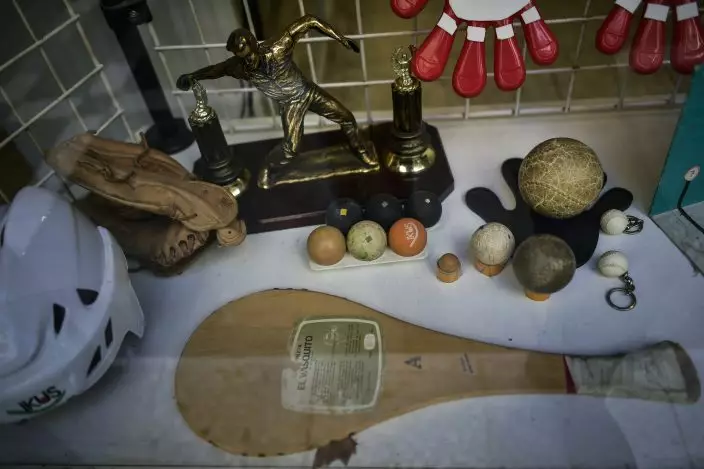
In this Thursday, Feb. 28, 2019 photo, Basque Balls items are displayed at a store in Pamplona, northern Spain. With their hands protected by layers of tightly-bound tape, the players take turns swatting a small, hard ball at speeds that reach 115 kilometers (71.4 miles) per hour. (AP PhotoAlvaro Barrientos)
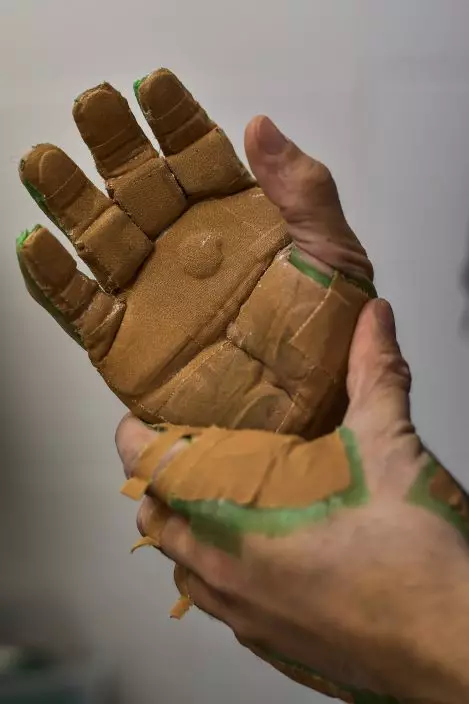
In this Thursday, Feb. 28, 2019 photo, Victor Esteban, 25 years old, a player of Basque Ball, known as "pelotari", prepares and protects his hands ahead of a training session, in Pamplona, northern Spain. With their hands protected by layers of tightly-bound tape, the players take turns swatting a small, hard ball at speeds that reach 115 kilometers (71.4 miles) per hour. (AP PhotoAlvaro Barrientos)
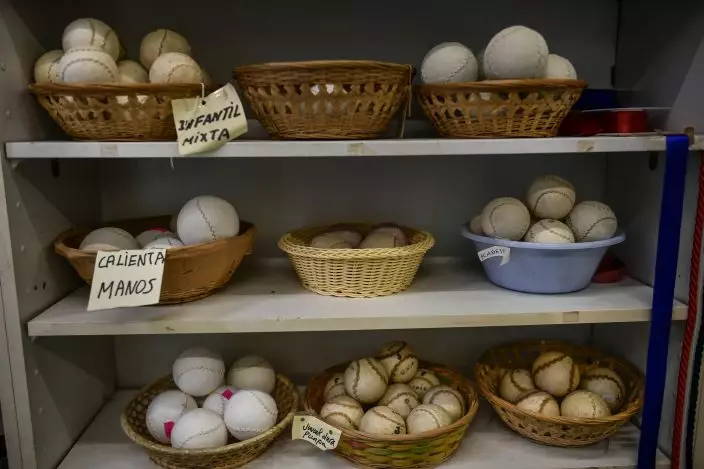
In this Thursday, Feb. 28, 2019 photo, different models of Basque balls are displayed for sale at a store in Pamplona, northern Spain. With their hands protected by layers of tightly-bound tape, the players take turns swatting a small, hard ball at speeds that reach 115 kilometers (71.4 miles) per hour. (AP PhotoAlvaro Barrientos)
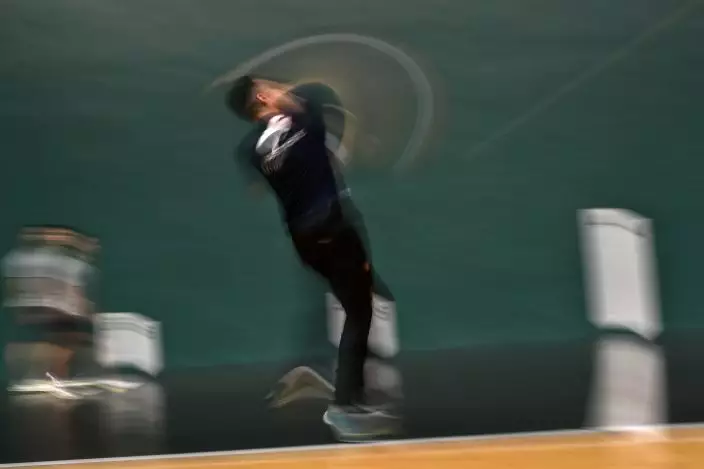
In this Thursday, Feb. 28, 2019 photo, Victor Esteban, 25, a player of Basque Ball, returns the ball on a Labrit court or fronton, in Pamplona, northern Spain. With their hands protected by layers of tightly-bound tape, the players take turns swatting a small, hard ball at speeds that reach 115 kilometers (71.4 miles) per hour. (AP PhotoAlvaro Barrientos)
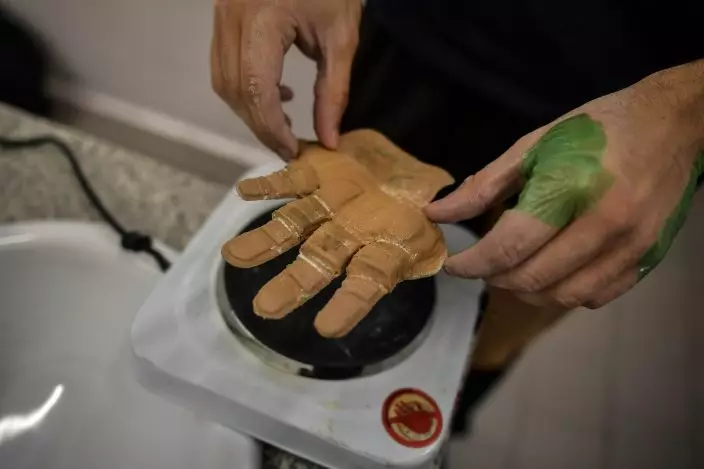
In this Thursday, Feb. 28, 2019 photo, Victor Esteban, a player of Basque Ball, known as "pelotari", prepares and protects his hands ahead of a training session, in Pamplona, northern Spain. With their hands protected by layers of tightly-bound tape, the players take turns swatting a small, hard ball at speeds that reach 115 kilometers (71.4 miles) per hour. (AP PhotoAlvaro Barrientos)
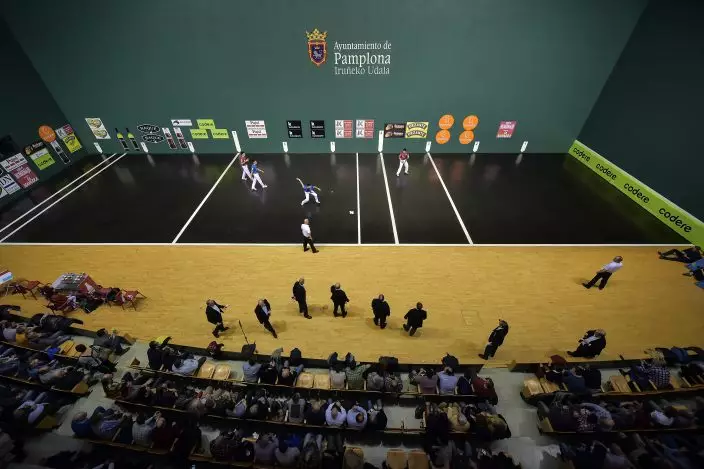
In this Saturday, March 9, 2019 photo, Victor Esteban, center, prepares to hit the ball with his hand during a match at Labrit court or fronton, in Pamplona, northern Spain. With their hands protected by layers of tightly-bound tape, the players take turns swatting a small, hard ball at speeds that reach 115 kilometers (71.4 miles) per hour. (AP PhotoAlvaro Barrientos)

In this Tuesday, March 5, 2019 photo, players of Basque Ball hold balls on their hands protected by layers of tightly-bound tape, in Pamplona, northern Spain. With their hands protected by layers of tightly-bound tape, the players take turns swatting a small, hard ball at speeds that reach 115 kilometers (71.4 miles) per hour. (AP PhotoAlvaro Barrientos)
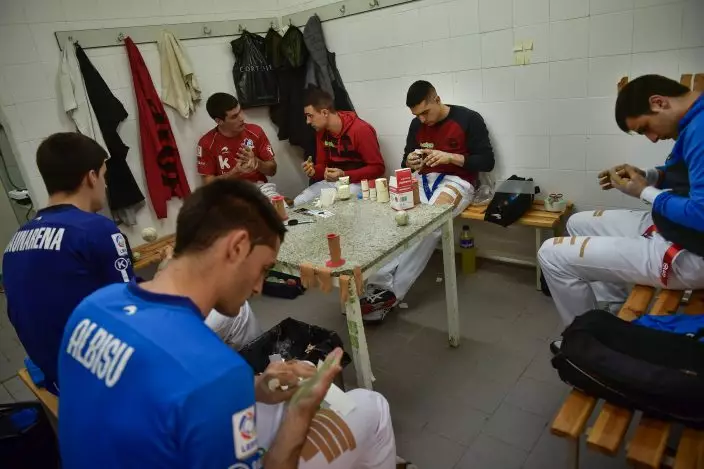
In this March 1, 2019 photo, players of Basque Ball known as "pelotari", use tape to protect their hands ahead of a match at Labrit court or fronton, in Pamplona, northern Spain. With their hands protected by layers of tightly-bound tape, the players take turns swatting a small, hard ball at speeds that reach 115 kilometers (71.4 miles) per hour. (AP PhotoAlvaro Barrientos)
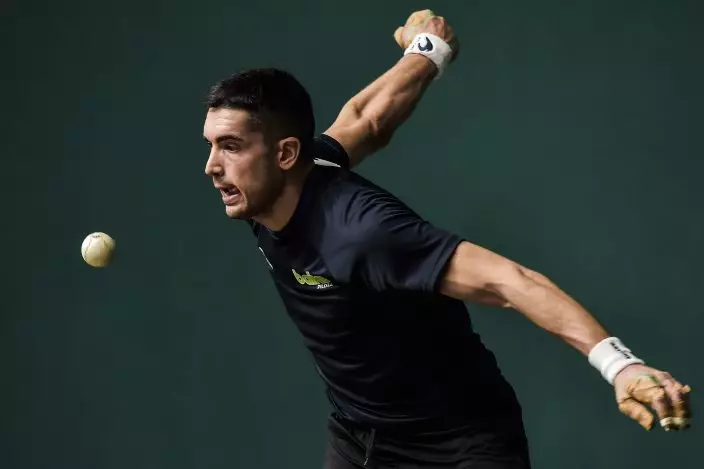
In this Thursday, Feb. 28, 2019 photo, Victor Esteban, 25, a player of Basque Ball, warms up at Labrit court or fronton, in Pamplona, northern Spain. With their hands protected by layers of tightly-bound tape, the players take turns swatting a small, hard ball at speeds that reach 115 kilometers (71.4 miles) per hour. (AP PhotoAlvaro Barrientos)
BEIRUT (AP) — The European Union announced Thursday an aid package for Lebanon of 1 billion euros — about $1.06 billion — much of which will go to boost border control to halt the flow of asylum seekers and migrants from the small, crisis-wracked country across the Mediterranean Sea to Cyprus and Italy.
The deal follows other EU aid packages for countries such as Egypt, Tunisia and Mauritania to fortify their borders. It comes against a backdrop of increasing hostility toward Syrian refugees in Lebanon and a major surge in irregular migration of Syrian refugees from Lebanon to Cyprus.
European Union Commission President Ursula von der Leyen said during a Beirut visit with Cypriot President Nikos Christodoulides that the aid distribution will start this year and last till 2027.
The bulk of the aid — 736 million euros — would go to support Syrian refugees “and other vulnerable groups” in Lebanon, while 200 million euros are meant to bolster Lebanese security services in enforcing border and migration control, according to figures provided by the Cypriot government.
An unspecified amount would go to Lebanese fishermen, to discourage them from selling their boats to smugglers.
Von der Leyen said the EU will also work on a “more structured approach to voluntary return" of Syrian refugees "in close cooperation with” the U.N. refugee agency. The bloc will continue to maintain “legal pathways” for resettlement of refugees in Europe, she said.
Lebanon's caretaker Prime Minister Najib Mikati praised the package, saying that “Lebanon’s security is security for European countries and vice versa,” and that an escalation of the crisis ”will not be limited to Lebanon but will extend to Europe."
Lebanon, which has been in the throes of a severe financial crisis since 2019, hosts nearly 780,000 registered Syrian refugees and hundreds of thousands more who are unregistered, the world's highest refugee population per capita.
Lebanese political officials have for years urged the international community to resettle the refugees in other countries or assist their return to Syria — voluntarily or not. Lebanese security forces have stepped up deportations of Syrians over the past year.
Tensions further flared after an official with the Christian nationalist Lebanese Forces party, Pascal Suleiman, was killed last month in what military officials said was a botched carjacking by a Syrian gang. The incident prompted outbreaks of anti-Syrian violence by vigilante groups.
Meanwhile, Cypriot authorities complain the island nation has been overwhelmed by irregular migration of Syrian asylum seekers, many of them coming on boats from Lebanon.
The UNHCR in Lebanon said it had verified 59 “actual or attempted” departures by boats carrying a total of 3,191 passengers from Lebanon between January and mid-April, compared to three documented boat movements carrying 54 passengers in the same period last year. Usually, few boats attempt the much more dangerous crossing in the winter. In all of 2023, UNHCR recorded 65 boat departures carrying 3,927 passengers.
Cyprus has taken a new approach to halting the flow of migrants. Last month, it suspended processing of Syrian asylum applications, and human rights groups accused the Cypriot coast guard of forcibly turning back five boats carrying about 500 asylum seekers coming from Lebanon. Cypriot officials have denied this.
Bassel al-Shayoukh, a Syrian refugee from Idlib living in Lebanon since 2014, said his brother and several cousins and nephews were on one of the boats turned back. Now he wants to make the journey himself.
“In the beginning I thought that in a year or two the war would be over in Syria,” he said, but it dragged on, while in Lebanon “every year ... the situation began to get worse.”
Shayoukh said he fears being beaten by vigilantes or deported to Syria after Lebanese authorities declined to renew his residency permit.
His 17-year-old nephew, who declined to give his name fearing for his safety, said the Cypriot coast guard started making waves to push the boat he was on away. “I was terrified... I don’t know how to swim,” he said. “I thought we were going to die.”
The people on the boats “stayed three days without food or water” before turning back to Lebanon, the teen added.
Back in Lebanon, they were detained by the army; those registered with UNHCR were released and the others deported.
Mohammed Sablouh, a Lebanese human rights lawyer who works on refugee and migrant cases, says Lebanese authorities are deliberately “turning a blind eye" to the surge in migration to "pressure the international community.”
The Lebanese army did not respond to a request for comment on their measures to combat smuggling.
Thursday's aid announcement comes ahead of the annual fundraising conference for the Syrian crisis in Brussels later this month. After 13 years of civil war, donor fatigue has set in while the world’s attention is occupied by the humanitarian fallout of more recent conflicts in Ukraine and Gaza.
The Cypriot president said Thursday was a “historic day” and called for European officials to go farther and declare some areas of Syria safe for return.
“The current situation is not sustainable for Lebanon. It is not sustainable for Cyprus, it is not sustainable for the European Union,” Christodoulides said.
But not all Lebanese officials are convinced the European aid would solve the problem.
Lebanese Forces party head Samir Geagea told The Associated Press earlier this week that European authorities are mainly concerned “that the refugees don’t go to Europe."
"For us the problem is that we cannot have our country drowning in illegal Syrian refugees,” Geagea said, urging for Syrians to be sent back to either government or opposition-held areas of the neighboring country.
But Shayoukh says he has nowhere to go.
The Damascus government wants him for opposing Syrian President Bashar Assad, he said, while the Islamist group that now controls his hometown behaves "the same way as the regime’s intelligence services” in crushing dissidents.
Associated Press writer Menelaos Hadjicostis in Nicosia, Cyprus, contributed to this report.
Follow AP’s global migration coverage at: https://apnews.com/hub/migration

Lebanese caretaker Prime Minister Najib Mikati, center, speaks during his meeting with Cyprus' President Nikos Christodoulides, left, and President of the European Commission Ursula von der Leyen at the government palace in Beirut, Lebanon, Thursday, May 2, 2024. (AP Photo/Hassan Ammar)

Lebanese caretaker Prime Minister Najib Mikati, center, speaks during his meeting with Cyprus' President Nikos Christodoulides, left, and President of the European Commission Ursula von der Leyen at the government palace in Beirut, Lebanon, Thursday, May 2, 2024. (AP Photo/Hassan Ammar)

Lebanese caretaker Prime Minister Najib Mikati, center, welcomes Cyprus' president Nikos Christodoulides, left, and President of the European Commission Ursula von der Leyen before their meeting at the government palace in Beirut, Lebanon, Thursday, May 2, 2024. (AP Photo/Hassan Ammar)

Lebanese caretaker Prime Minister Najib Mikati, center, Cyprus' President Nikos Christodoulides, left, and President of the European Commission Ursula von der Leyen pose for photograph at the government palace in Beirut, Lebanon, Thursday, May 2, 2024. (AP Photo/Hassan Ammar)

Lebanese caretaker Prime Minister Najib Mikati, right, welcomes Cyprus' president Nikos Christodoulides before their meeting at the government palace in Beirut, Lebanon, Thursday, May 2, 2024. (AP Photo/Hassan Ammar)

Cyprus' President Nikos Christodoulides, left, and President of the European Commission Ursula von der Leyen, center, review an honor guard upon their arrival to meet with the Lebanese Speaker Nabih Berri, in Beirut, Thursday, May 2, 2024. (AP Photo/Hussein Malla)

Lebanese caretaker Prime Minister Najib Mikati, center, speaks during his meeting with Cyprus' President Nikos Christodoulides, left, and President of the European Commission Ursula von der Leyen at the government palace in Beirut, Lebanon, Thursday, May 2, 2024. (AP Photo/Hassan Ammar)

Lebanese caretaker Prime Minister Najib Mikati, center, welcomes Cyprus' President Nikos Christodoulides, left, and President of the European Commission Ursula von der Leyen at the government palace in Beirut, Lebanon, Thursday, May 2, 2024. (AP Photo/Hassan Ammar)
































